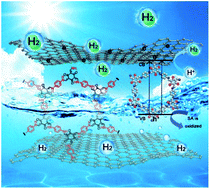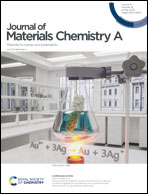Facile synthesis of a covalently connected rGO–COF hybrid material by in situ reaction for enhanced visible-light induced photocatalytic H2 evolution†
Abstract
Covalent organic frameworks (COFs) have shown promising visible-light-driven hydrogen evolution activity, but improving the separation and migration of photogenerated electron–hole pairs is still the key point for further increasing their activity. In this work, for the first time, we designed and synthesized a new type of covalently connected rGO–COF photocatalyst for enhanced hydrogen evolution. A series of rGO–TpPa-1-COFs was obtained by a facile one-pot reaction through adding GO to the synthetic system of TpPa-1-COF with DMF as a solvent, which led to the reduction and functionalization of GO and further covalent connection with the COF as confirmed by various characterization techniques. The resulting rGO(5%)–TpPa-1-COF showed a H2 evolution rate of 11.98 mmol g−1 h−1 under visible-light irradiation, which was 4.85 and 2.50 times higher than those of pure TpPa-1-COF and 5%rGO/TpPa-1-COF without any covalent connection between the two components, respectively. Further investigations confirmed that the covalent connection between the rGO and TpPa-1-COF components not only served as a “band” to tightly combine these two types of 2D material together, but also acted as a “bridge” to largely improve the separation of photogenerated charges of the COF as well as the migration of photogenerated electrons to rGO, thus leading to the resulting enhanced H2 evolution activity.



 Please wait while we load your content...
Please wait while we load your content...